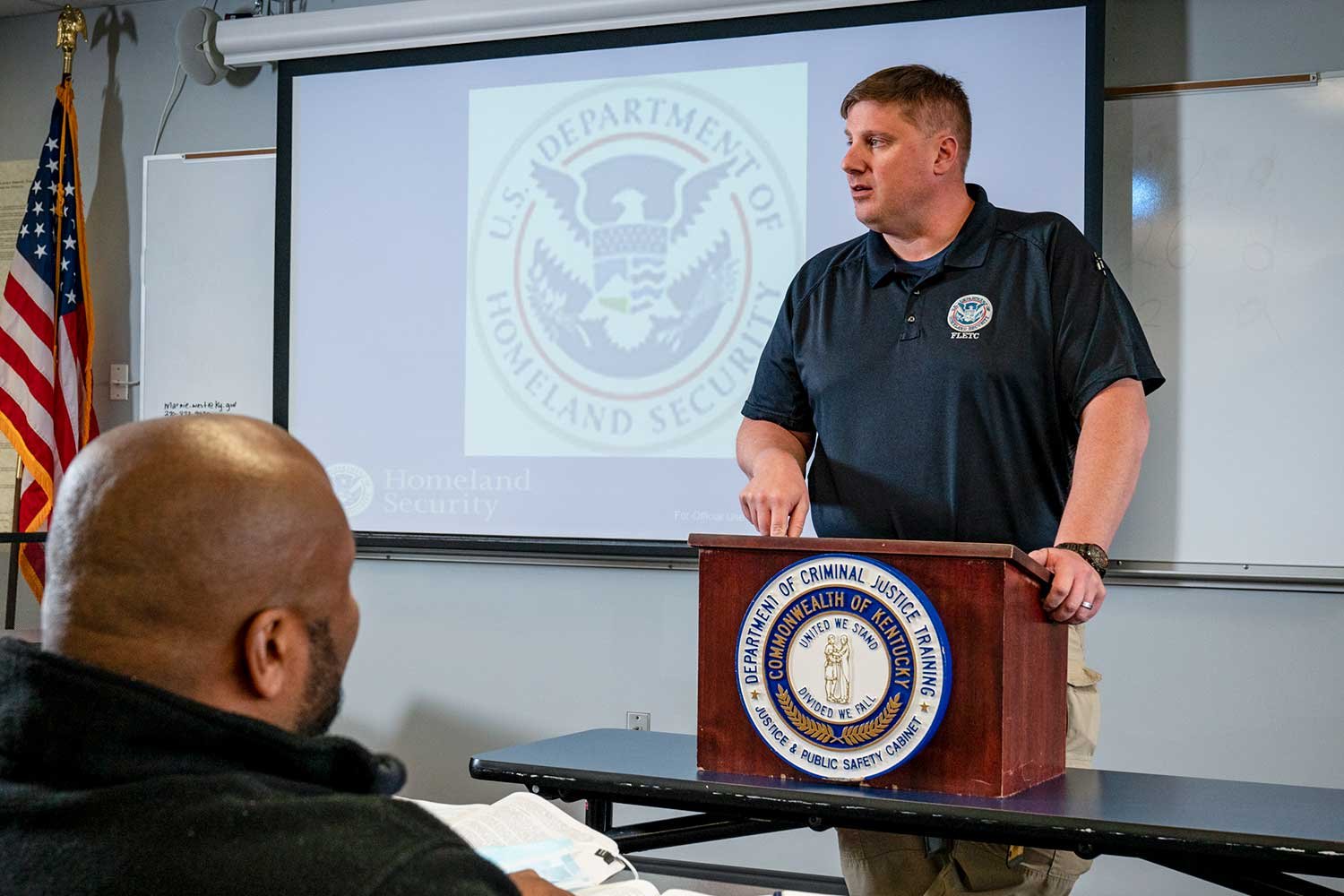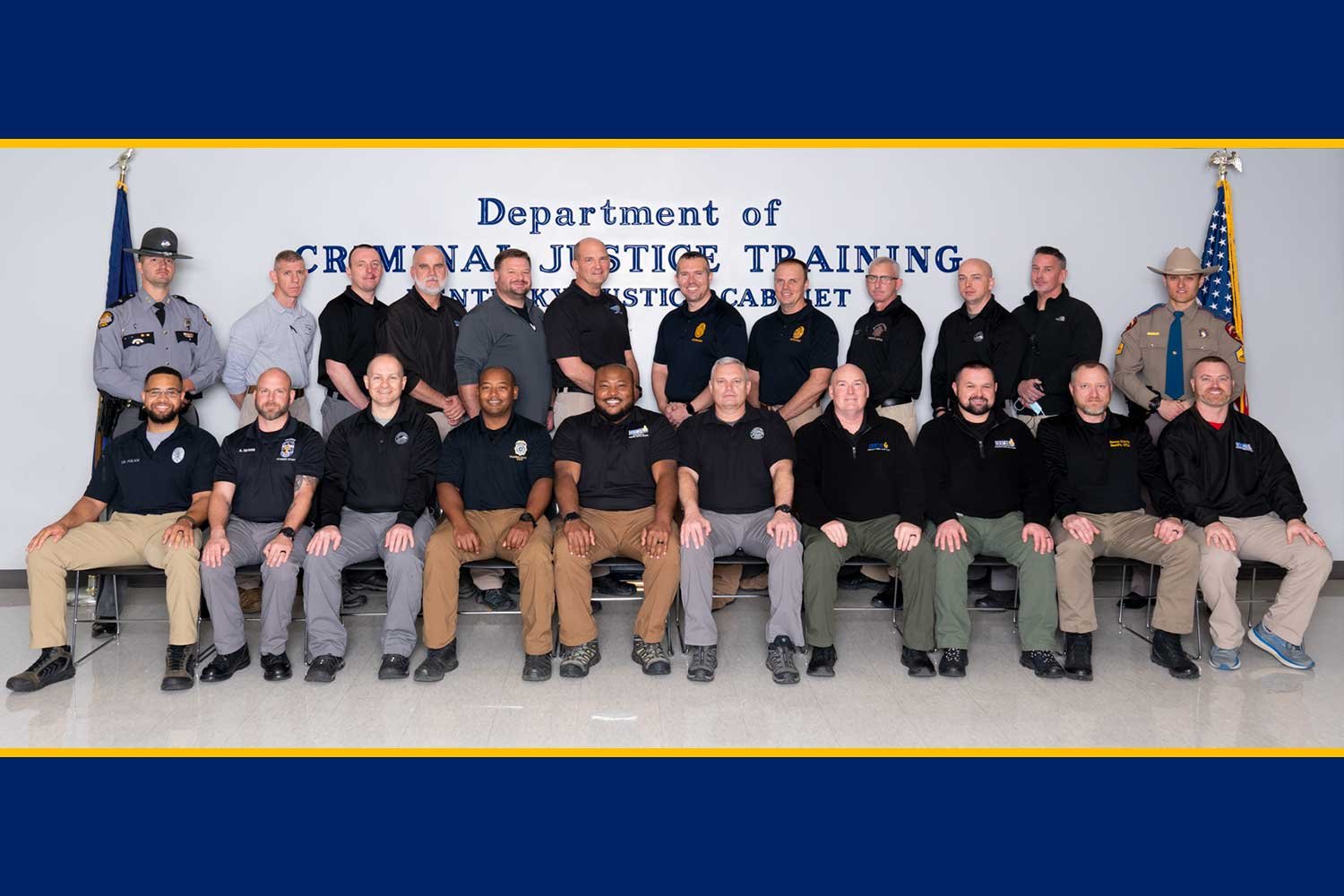Making the Correct Call
PICTURED ABOVE
Jeff Dolson, lead instructor FLETC’s Enforcement Operations Division, was one of several FLETC trainers who presented an 80-hour use of force training class at DOCJT in early January. (Photo by Jim Robertson)
During a career, law enforcement officers are often put into situations where they must make split-second decisions regarding use of force.
In many of these instances, the situations are tense, rapidly evolving, dynamic, and uncertain. Officers involved in the decision to use force, especially deadly force, are subject to criminal law, civil torts, and the scrutiny of their respective departments, which often have more restrictive use of force policies than the law. Many of those decisions are based on experience and training.
The Department of Criminal Justice Training (DOCJT) hosted the Federal Law Enforcement Training Center’s (FLETC) Use of Force Instructor Training Program (UOFITP) in early January. Instructors from every Kentucky law enforcement training agency – DOCJT, Louisville Metro, Lexington, and the Bowling Green police training academies, and the Kentucky State Police Academy – along with training officers from other Kentucky police agencies participated in the program.
The two-week, 80-hour course off gave law enforcement instructors and officers the knowledge and skills to better evaluate training, implement improved training strategies improved learning and performance, and an in-depth understanding of the Constitutional Amendments and federal and state laws upon which the police use of force is scrutinized by the courts.
“UOFITP is designed to give students the knowledge and skills necessary to successfully design, develop and implement use of force training using static, dynamic, and interactive principles,” according to the FLETC curriculum.
The training included all aspects of use of force training to include uniformed presence, communication skills, empty-hand techniques, appropriate use of intermediate weapons (pepper spray, Taser, and baton), firearms decision and weapon transition training.
(Photo by Michael Moore)
January’s class marks the first time FLETC presented this newly developed training in Kentucky, which will be taught nationally throughout the year. Five DOCJT instructors from its three critical skills sections successfully completed the program.
“We give a foundation of the law and practical applications on when to employ use of force,” said Jeff Dolson, FLETC lead instructor with the Enforcement Operations Division. “Then we go through scenarios and build it from the instructor’s standpoint in terms of how they will take it back to their agency and train new trainees, newer officers, and older officers.”
The course targets law enforcement professionals who train officers in the principles of use of force, develop or revise use-of-force policy, and are responsible for reviewing and evaluating of agency use of force incidents.
The course uses adult-learning principles and problem-based training, role-play, weapon transition drills, lectures and demonstrations to give students the skills necessary to develop and teach their training programs related to the use of force.
“We talk about how we learn and how we train – the subconscious and the conscious,” Dolson said. “When they are faced with a tense and rapidly evolving situation, they respond legally with what they can do as their subconscious takes over. They recognize things that are happening so quickly that their body, because of self-preservation, is already going through the steps needed to protect themselves or that third person.”
UOFITP is essentially a critical decision-making program that examines when officers can use force. Dolson explained that the course addresses what force means, both legally and in practical applications.
“This critical decision-making training empowers officers to say, ‘Yes, I did the right thing, and the training I received is good,’” Dolson said. “And we’re adding on to that an extra layer when we communicate that.”
If an officer can get all these facts out in an interview or on their report when it is read, it can put the reader in the same situation the officer was faced with.
Using plain language when it comes to documentation or giving statements and avoiding conclusionary statements and police jargon were also covered. Officers must learn to communicate in plain, descriptive terms that clearly illustrate the facts.
“(Law enforcement officers) like to use a lot of cop speak,” Dolson said. “Those terms don’t resonate with the public, politicians, juries or the judge because they don’t understand our job. What we try to do is speak in the language everyone can understand.”
The use of force training includes blocks on legal decisions related to the use of force, Dolson elaborated.
“We back it up in court,” he said. “Whether it’s (U.S. Supreme Court rulings) Graham v. Connor, Tennessee v. Garner, or Scott v. Harris – We need to be able to say that we believe our suspects when they say they’re going to hurt us. We don’t have to respond to the (actual) use of force. We can respond to the threat of force because we know that action is quicker than reaction.”
(Photo by Jim Robertson)
Taking it Home
One of the main goals of the 80-hour training is helping instructors at the state and local level take what they’ve learned and incorporate it into training at their agencies.
Boone County Sheriff’s Office retired Lt. Doug Studer, who works with that department’s training staff, is eager to take what he’s learned back to his northern Kentucky agency.
“It’s going to add realism to the training that we will put on,” Studer said. “It’s going to be beneficial because we can put the training officers and deputies that we’re going to be training through scenarios to build the memory of how to react when confronted with certain situations and how I react in training is an option of how to react when they’re out on the road. It will take the hesitation out of them because they have seen it before.”
The FLETC training also includes templates for conducting training, from classroom lectures to scenarios and role-playing, which is beneficial, Studer said.
(Photo by Michael Moore)
Student-Centered Feedback Model
While there are many key pieces of information the instructors in attendance hope to pass on to their students, the Student-Centered Feedback Model (SCFM) caught the attention of DOCJT Tactics Section Supervisor Shannon West.
“This method goes a long way in (trainees) retaining the knowledge taught,” West said. “The (SCFM) will change the way we do business here.”
SCFM asks the trainees what they did right versus asking them why they performed a task a certain way.
West said that when the student is forced to think through what they did, it allows them to process what happened, and they explain what they thought happened, what they did well, where they may change their approach, and examine alternatives to their use of force options.
(Photo by Jim Robertson)









